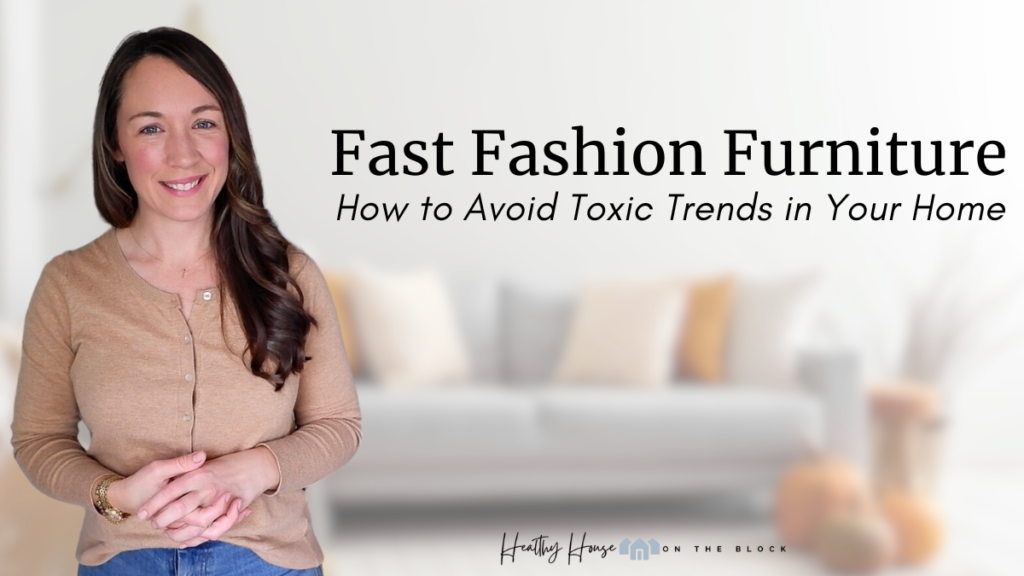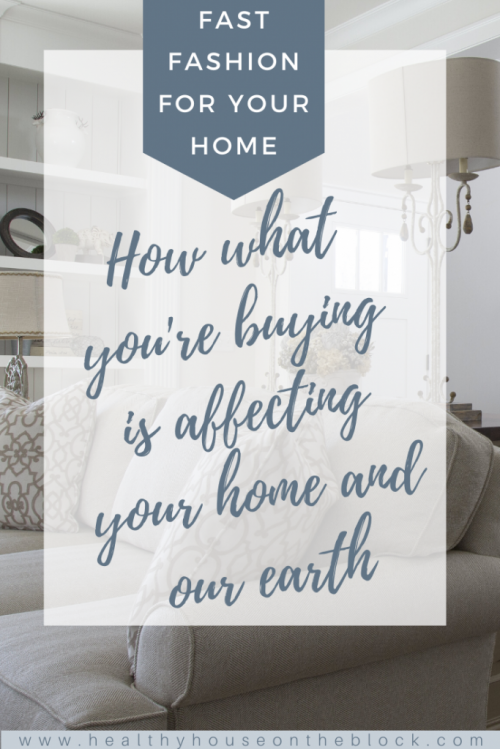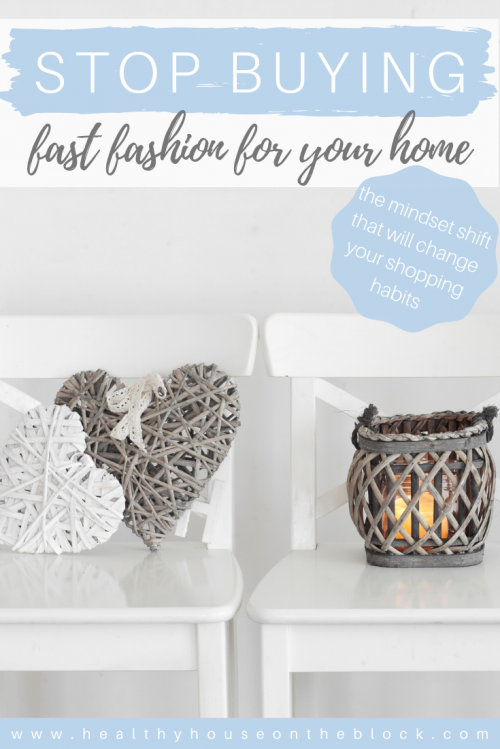
You might be wondering a few things based on the title of this post. First, what is fast fashion? Fast fashion is inexpensive clothing and accessories produced by mass-market retailers in a quick fashion in order to respond to the latest trends. Often the outcome is cheap, low quality pieces that get tossed or donated within a short amount of time.
Second, you might be wondering why I’m even mentioning on a healthy home blog? Well, it’s more a comparison than anything else to the types of furniture and decor we’re buying in our homes. The trends for home decor and furniture change frequently and mass producers of furniture like Wayfair, Target and Ikea have made it easy to swap out pieces quickly and get rid of the old whenever we please.
Believe me when I say it doesn’t mean you have to have the same items in your house for all of time. Trust me, I like new things too. I think it’s more about being really intentional with what we purchase and bring home and less about the idea of swapping things out on a regular basis.
You know my motto around here is to be the keeper of your home rather than the manager of all your stuff. Meaning, pay attention to what you’re bringing in and don’t buy anything unless it’s REALLY going to stay in your house for the long haul.
So while this isn’t a fashion blog or post, I’m using the idea of fast fashion to compare to the way we buy for our homes as well.
WHAT IS FAST FURNITURE AND DECOR?
The idea behind fast furniture (yes, this is a term I’ve made up myself) is that it includes mass produced, cheaply made, inexpensive furniture and decor for your home. Think about the aisles at Target with the home decor and furniture. These items are in EVERY Target store across the country. That’s a lot of each item.
Wayfair, Ikea and other online retailers are the same. You can order just about any home decor item or piece of furniture at any point in time and receive it within a few days. These items are mass produced and ready to be sent out at any time. Sometimes the items are of higher quality, but more often than not they’re not made with the same care and quality of items from long ago.

THE PROBLEM WITH FAST FASHION FOR YOUR HOME
There’s actually a number of problems with this idea of fast fashion furniture and decor that range from issues in our environment at home, harm to the earth and financial effects.

Adding Toxins to the Home Environment
Because furniture and decor that is mass produced is often made to be inexpensive in cost, it has to be made inexpensively too. This means using materials and products that aren’t high quality to save on the cost.
Many times furniture that is inexpensive is not made with solid wood, but instead made with particle board, plywood and medium density fiberboard. These types of wood commonly contain formaldehyde as a strong adhesive is needed to hold the wood together and in shape. (Study). Formaldehyde is a known carcinogen and it’s potency doesn’t lessen over time.
In fact, quite the opposite. Formaldehyde off-gassing increases as the material and product ages.
Formaldehyde isn’t the only toxin being added to our homes through the purchasing of inexpensive furniture and decor. Plastic is another huge trend in home furnishings. Plastic is inexpensive and it can be quite easily mass produced. Plastic has been linked to endocrine system disruption as well as linked to various kinds of cancer when exposed for long periods. (Study). Plastic has also been linked to brain development problems, obesity, infertility and ADHD (Study)
Harm to our Earth
With the mass production of so many pieces of fast fashion furniture, our environment OUTSIDE hasn’t fared so well either. Pollution in our air and water comes from the mass production of both furniture as well as decor. Sawdust containing VOCs and other particulates end up in water near furniture manufacturing plants, contaminating the water. (Study)
The waste from furniture production is also a huge problem as many of the items are not biodegradable, like plastics and vinyls. (Study) There are also issues with the solvents, glues and paints that end up adding VOCs to the air and water over time when they are left over and unused.
And it’s not just the furniture production itself. On top of this, most furniture has to be shipped from the manufacturer to the retailer and finally to the buyer. The constant shipment of products is causing an increasing tax on our environment and increasing the carbon footprint affecting our earth (Study).
Financial Issues
Let’s be completely honest here – I love a good deal. So much so, that inexpensive furniture and decor can look pretty appealing. But the truth is that inexpensive, cheaply made decor and textiles don’t last. And for good reason — they’re meant to be fast and quick to meet the home decor trends. This means that they’re only meant to last until the next trend comes along.
Often this means a company mass produces something new and they keep you coming back in a cycle of purchasing and swapping out furniture and decor. This in turn creates a spending habit and cycle of purchases that eats away at bank accounts, as we spend more and more money. (Fast Company Article)
THE MINDSET SHIFT TO CHANGE
The real key when it comes to shifting your mindset is to think about furniture as truly long term. Many of us buy something and assume within 5 years or so we’ll trade it in for whatever the new trend is. This is obviously more than just a mindset problem with furniture, but rather a problem with how we think about most of our purchases. As a society we’ve come to embrace an “instant gratification” way of living where we buy what we want in the moment and don’t think about the future repercussions.
Fast fashion furniture incorporates this way of thinking to a tee. To reverse this, think long term. Imagine your home or your life in 10 years. Is the item your purchasing timeless enough to fill that image? Opt for furniture that is neutral in color so the temptation to change it based on the outdated color or pattern isn’t there. Instead, add color with smaller items that are more inexpensive.
And of course, I couldn’t leave out that you must be intentional with your purchases. Be the keeper of your home instead of just buying whatever looks good. This might involve waiting to make a purchase and allowing yourself time to think about it. Or it might mean doing research on an item you’re going to buy before truly committing to the item.

SOLUTIONS TO FAST FASHION FOR YOUR HOME (FURNITURE AND DECOR)
Instead of buying into fast fashion furniture and decor, there are a couple changes you could make to HOW you purchase items. Because, like I said, it doesn’t mean you have to stick with the same thing forever, but swapping it out frequently isn’t the best long term plan.
Craigslist and Facebook Marketplace is one of my favorite places to hunt for unique furniture at an exceptionally low cost. Look for pieces that are made of solid wood to avoid bringing in any toxins. If you’re going to be refinishing a piece of furniture, you can use my recommended products to help make the furniture a healthy addition to your healthy house.
Etsy is a great way to get something completely unique and one of a kind. There are so many great shops on Etsy that have beautiful home decor and even furniture. I love supporting individuals who create products rather than large brands if I can help it. It doesn’t always work out that way, but I’m making more and more of an effort to check on Etsy for an item first.
Custom Made is an option that we often times forget about. There are often times local companies and individuals right in your community that create furniture and decor customizable to you. I live in Minnesota, and right in my own city is a custom furniture company that specializes in making items as they come in rather than producing them in large amounts.
Reuse what you have. You can refinish your own furinture, give it a coat of VOC free paint or give it some new pillows to change the look. In addition, you can usually find upholstery companies that can either make components of furniture or recover what you have in order to change the look. In Minnesota, I found a local seamstress specializing in using eco friendly and natural textiles when she refinishes furniture and cushions.
Third Party Certifications are the other components of changing the way you buy. If ou can’t go local, handmade or handed down, then looking for a third party certification is another way to protect yourself and the environment. Be sure to look for GreenGuard and GOLS when it comes to furniture as they also look at the manufacturing of items in addition to the product itself.

Need to know more about healthy furniture and decor items? Check out these posts to avoid fast fashion for your home:
Share this:
- Click to share on Facebook (Opens in new window) Facebook
- Click to share on LinkedIn (Opens in new window) LinkedIn
- Click to share on Reddit (Opens in new window) Reddit
- Click to share on Pinterest (Opens in new window) Pinterest
- Click to print (Opens in new window) Print
- Click to share on X (Opens in new window) X




Pingback: Healthy Building Materials from the Green Design Center: Advice & Tips